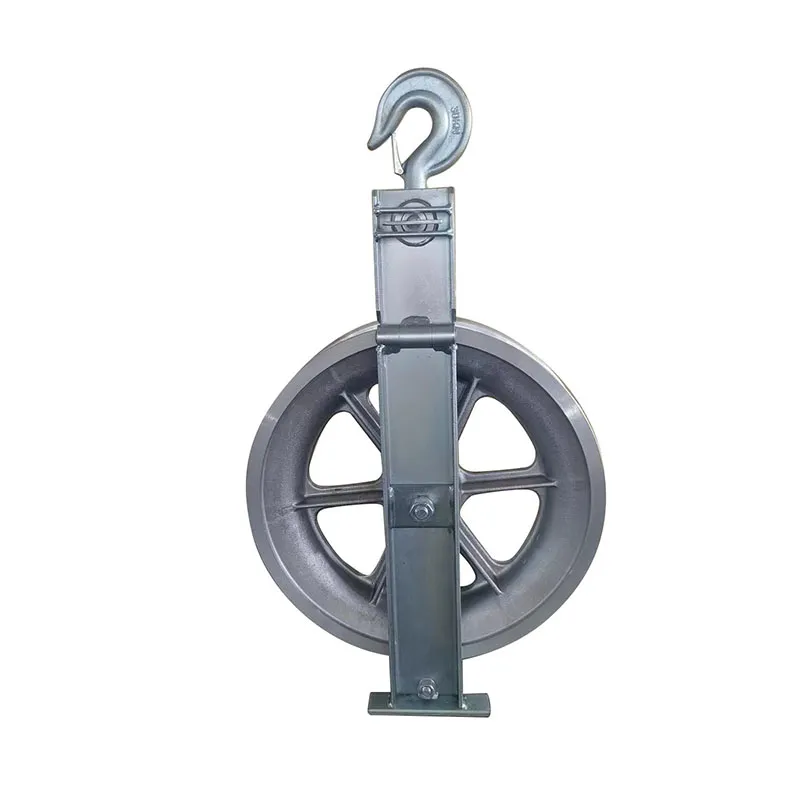The Importance of Stringing Blocks in Power Line Construction
2024-09-05
In the world of power line construction, stringing blocks play a crucial role in ensuring the efficient and safe installation of power cables across long distances. Whether it's high-voltage transmission lines or distribution lines, stringing blocks, also known as pulleys or sheaves, are essential tools that allow cables to be strung securely and without damage. In this blog, we’ll dive into what stringing blocks are, how they work, and why they are so vital to the power industry.

What Are Stringing Blocks?
Stringing blocks are specialized pulleys designed to guide and support power cables during the stringing process. Typically made from high-strength materials like aluminum or nylon, these blocks are designed to withstand the weight and tension of power cables as they are pulled through the system. They come in various sizes and configurations, depending on the type of cable and the terrain.
Each stringing block consists of a rotating wheel that helps minimize friction, allowing the cable to glide smoothly. This is particularly important in reducing the stress on the cable, which can prevent wear and tear, elongation, or damage during installation.
Types of Stringing Blocks
There are various types of stringing blocks available, each designed for specific applications in power line construction:
- Single Sheave Stringing Block: This is the most basic type and is used for installing one cable at a time. It is often used in lower-voltage distribution lines.
- Multiple Sheave Stringing Block: Designed to handle multiple cables simultaneously, these blocks are ideal for installing bundled conductors on high-voltage transmission lines.
- Nylon Stringing Block: Known for its lightweight and durability, nylon blocks are preferred for certain types of conductors where reducing friction is critical. Nylon stringing blocks also have the added advantage of electrical insulation.
- Aluminum Stringing Block: Aluminum blocks are known for their strength and are used in heavy-duty applications, such as installing high-voltage lines over long distances or rough terrains.
- Helicopter Stringing Blocks: These blocks are specially designed for use in helicopter-assisted cable installation, where cables are laid over tall structures or across difficult terrain. They are often used for transmission lines that span valleys, rivers, or densely forested areas.
How Stringing Blocks Work
The primary function of stringing blocks is to reduce the friction and tension that occur when pulling electrical cables through transmission towers or poles. Here's how they work:
1. Cable Placement: The stringing block is mounted to the transmission tower or pole. The cable is threaded through the block’s sheave, ensuring that it rests within the groove.
2. Cable Pulling: Using a pulling device, the cable is then drawn through the block. As the cable moves, the rotating sheave reduces friction, allowing the cable to be pulled smoothly without excessive strain.
3. Cable Positioning: The block ensures that the cable is positioned correctly and remains secure as it is pulled through multiple towers or poles. After installation, the block can be opened, allowing the cable to be positioned on its final attachment points.
4. Tension Reduction: Stringing blocks prevent the excessive tension that could cause the cable to stretch or even snap, especially over long distances or steep inclines.
Benefits of Using Stringing Blocks
1. Cable Protection: One of the most important functions of stringing blocks is to protect cables from damage during installation. Without these blocks, the cable would be subject to extreme tension and friction, leading to wear and tear or even breakage.
2. Efficiency: Stringing blocks make the cable installation process more efficient by reducing the effort required to pull the cable over long distances. This allows contractors to complete projects more quickly, saving both time and labor costs.
3. Safety: Stringing power cables over long distances or rough terrain can be dangerous without the proper tools. Stringing blocks ensure that cables are safely guided through the system, reducing the risk of accidents or cable failures during installation.
4. Versatility: Stringing blocks come in many sizes and configurations, making them suitable for a wide range of power line projects, from small distribution networks to large-scale high-voltage transmission lines.
5. Longevity of Infrastructure: Proper cable installation, aided by stringing blocks, ensures that power lines will remain functional for years without unnecessary maintenance. Damage during installation can lead to costly repairs or shortened cable lifespan.
Applications of Stringing Blocks
Stringing blocks are used in various sectors of the electrical industry, including:
- Transmission Line Installation: High-voltage transmission lines require precise and durable equipment to handle the heavy cables. Stringing blocks ensure the smooth installation of these cables over vast distances.
- Distribution Networks: Stringing blocks are also used for lower-voltage distribution lines that deliver electricity to homes and businesses.
- Telecommunication Lines: Stringing blocks are often used for fiber optic cable installation in telecommunication networks, ensuring that sensitive cables are installed without damage.
- Railway Electrification: In railway electrification projects, stringing blocks are used to install overhead cables that power electric trains.
Conclusion
Stringing blocks are an indispensable tool in the construction and maintenance of power lines and other cable systems. Their ability to reduce friction, protect cables, and enhance the safety and efficiency of installation projects makes them vital to the success of large-scale infrastructure projects. Whether you are dealing with high-voltage transmission lines or fiber optic cables, stringing blocks play a critical role in ensuring the integrity and reliability of the electrical grid.


